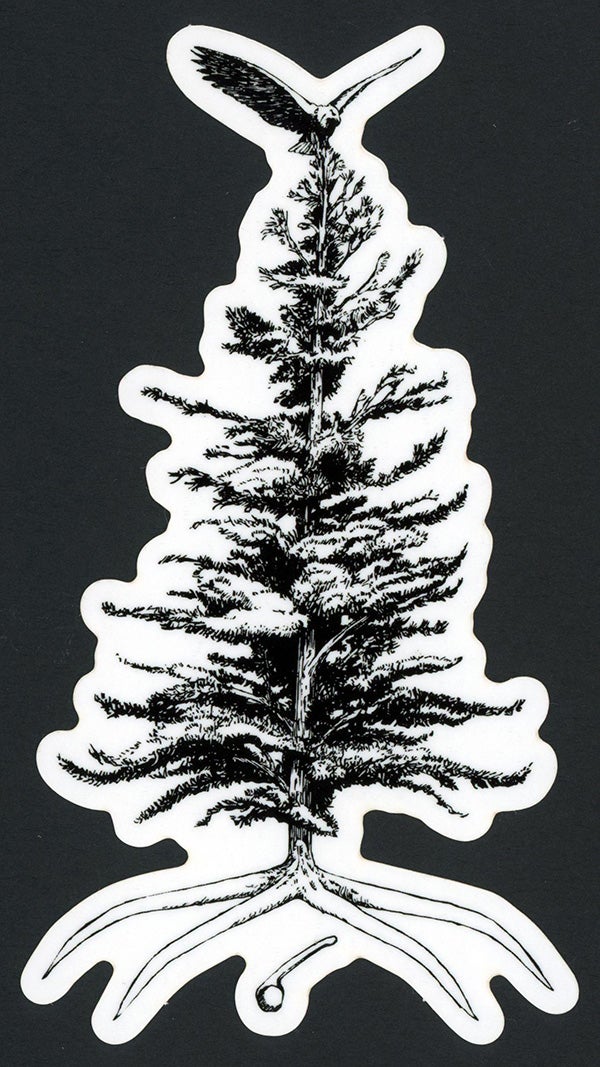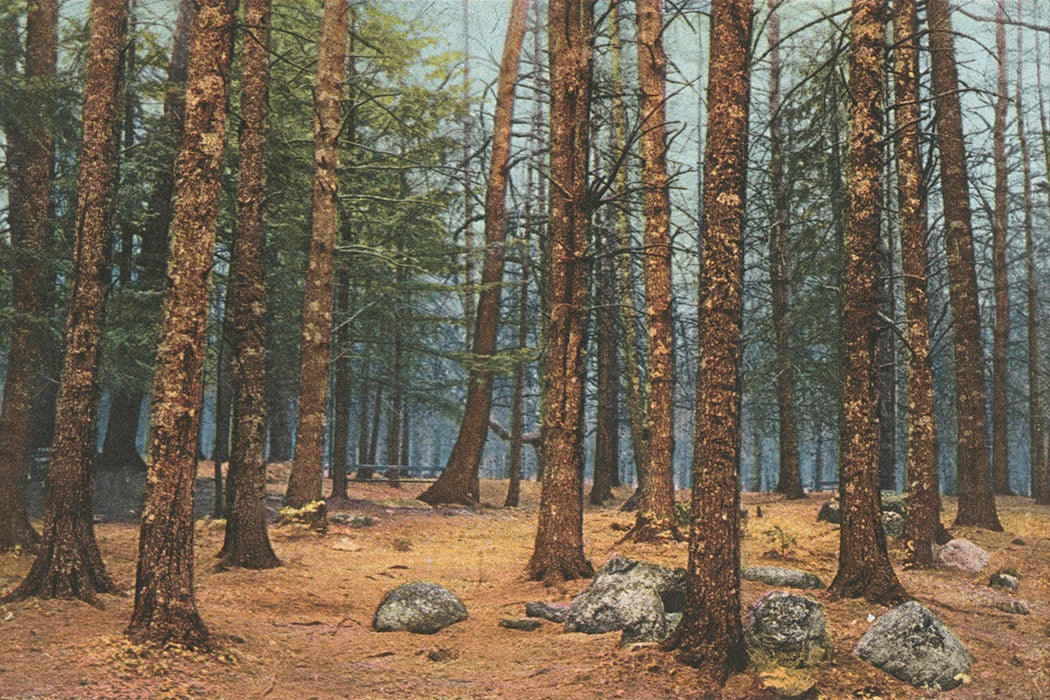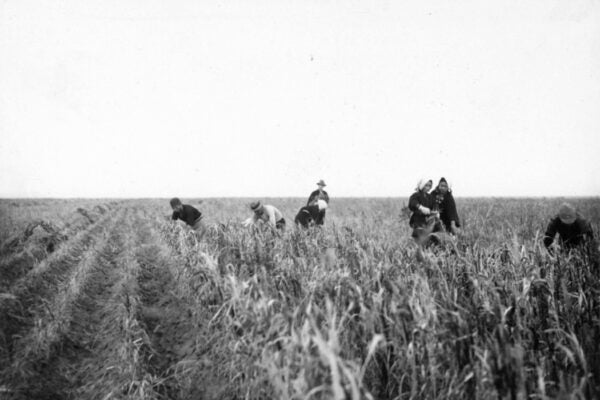Though the image of incensed colonists dumping tea into Boston Harbor in the period leading up to the American Revolution is iconic, a different kind of uprising may have more directly led to war against the Crown.
Soon after British ships landed in North America in the sixteenth century, it became clear that this new world had a prized item in abundance: wood. The British Empire ruled by sea, and it required large tree trunks for the masts of its tall ships. Having mostly denuded the once expansive forests of the British Isles, Britain and other European powers including Spain and France had looked east, sourcing mast wood from the Baltics. But by the early seventeenth century, high-quality timber in that region was diminishing too, as the Baltic forests had been depleted and reforestation policies were wanting at best.
In New England, however, the British found more than a replacement for what they’d exploited elsewhere. Everywhere the colonists looked, they saw trees taller and thicker than any they had known back in England. Almost immediately, they recognized the value of one species in particular, the Eastern white pine.
Weekly Newsletter
Known to Western science as Pinus strobus, the white pine covered the coasts from what is now Maine down to northern New Jersey. Its strong, straight trunks rose as high as 150 feet. When colonists cut down the first big pines in New England, it became apparent that nearly everything they needed most in this new land, the pine provided. Strong and durable, the tree was generally resistant to rot and waterlogging, and was largely unsullied by knots or deformities. Its wood was the perfect material for building ship masts, but also house frames, roof shingles, and more.
“No man ever cut down a pine, and lived to see the stump rotten,” went an early colonial saying.
The white pine had been treasured long before the colonists arrived. It had practical uses for the Indigenous communities of what would become New England, but it also served as an important symbol. The Haudenosaunee, also known as the Iroquois Confederacy, is made up of six groups with ancestral tribal lands primarily covering a large swath of present-day New York state. Their system of government is based on the Kaianere’kó:wa, or the Great Law of Peace. The first Haudenosaunee alliance, then made up of five tribes, convened under a “Tree of Peace,” a tall white pine, and each of the allied nations buried weapons at its base in a symbolic gesture of unity.

In his article on the history of Eastern pines, historian Charles van Ravenswaay, quoting William Darlington’s 1837 book Flora, reports that
throughout the Northern states, “except in the larger capitals, seven-tenths of the houses are of wood, of which three quarters, estimated at about 500,000, are almost wholly of White Pine: even the suburbs of the cities are built of wood. The principal beams of churches and the other large edifices are of White Pine.”
In addition to being essential to ship- and house-building, wood was the primary fuel for colonial life. While the biggest pines were felled for masts and church steeples, many more trees were cut down for burning to heat homes and other buildings. Pines—like trees of other species—were also felled to clear would-be agricultural fields.
The colonists cut white pine at an extraordinary and unsustainable rate. The town of New London (formerly Pequot), Connecticut, was founded in 1646; only thirteen years later, it passed a law limiting deforestation of local pines. By the 1690s, a British customs agent remarked that trees big enough for ship masts were becoming rare along the New England coast. Logging teams went farther and farther inland to satisfy this hunger, but because they lacked modern technology for loading and shipping logs, each mile inland required painstaking labor to clear a transport path to the nearest port.
Across the ocean, royal officials took notice of the thinning colonial woods. Clearly, the Crown would have to step in to impose some kind of regulation, or there would soon not be enough big trees to maintain the Royal Navy in its seemingly unending wars.
The 1691 Massachusetts Charter officially founded Massachusetts Bay as a province of the British Empire. Part of that document, issued by King William III and Queen Mary II, included the first royal decree on the white pine. Anywhere in the province, the charter said, any tree over twenty-four inches in diameter was the property of the crown and the Royal Navy. A fine of 100 pounds was set for the cutting of any such tree without permission from the monarchy.
The colonists were undeterred by the edict. In 1698, twenty thousand white pine boards traveled south from the city of Springfield in central Massachusetts to Hartford, Connecticut, in an example of the free-for-all harvesting taking place across the species’ geographic range. The British passed three more laws, known as the White Pine Acts, in 1711, 1722, and 1729 to widen and strengthen their restrictions. They created a new office, the Surveyor General of His Majesty’s Woods in America, to enforce the Acts and endeavor to keep the supply of mast wood for themselves.
They didn’t, however, account for the resolve of newly powerful New England families—such as the Wentworths—who had built their homes and, moreover, their fortunes on the white pine. These families would not be threatened by the declarations of a far-away king. As happened throughout the colonies on a range of issues, the rift between the Empire and its subjects only deepened throughout the early eighteenth century.
The “Pine Tree Riot,” as it’s called, is often misattributed to a single event, when it arguably alludes to various acts of resistance. The first of these came in 1734, just five years after passage of the third and most restrictive White Pine Act. Deputies to the surveyor general, Colonel David Dunbar, were lodging in Exeter, New Hampshire, as they inspected local sawmills to ensure compliance with the ban. One night, they awoke to find their house surrounded by armed locals who broke in, pulled them from their beds, and beat them before running them out of town. When Dunbar heard of the attack, he traveled to Exeter himself and took his revenge on one of the town’s sawmills, seizing logs and destroying equipment. Workers at a neighboring sawmill responded in solidarity, firing shots at Dunbar and his hired crew, forcing them to flee.
The events in Exeter offered a template for subsequent pine tree conflicts over the next four decades: violent, often armed, resistance to an official of the British Crown, followed by little, if any, response. But why would the British Empire, notorious for its harsh response to revolutionary ideas in its colonies, allow for clear violations of its authority go unpunished? The answer has to do with the conflicted nature of colonial politics and the importance of the white pine to every aspect of New England life.
In 1741, Benning Wentworth became the governor of New Hampshire, appointed by the king. A former merchant and member of the state assembly, Wentworth had been in the white pine business most of his life. His brother Mark sold mast wood to the Royal Navy. The governorship was a powerful position, but it’s a testament to the central place of pine logging in the New Hampshire economy that soon after his appointment, he bought the rights to another position as well: Surveyor General of the King’s Woods in America. By the 1750s, he was in charge not only of one state’s government but also of one of the leading industries in the entire region.
Unlike previous surveyors general, Wentworth took a pragmatic view of the conflict over the white pine. In his opinion, as long as enough mast trees made their way to London to keep the Crown happy, there was no reason to trouble the industry that had made him and others rich. He used his new dual power to enforce the White Pine Acts only as much as absolutely necessary while amassing influence by giving rewards like land grants and town charters to those who were loyal. Soon, the state house was firmly under his control. The requirements for holding a seat there included owning at least 300 pounds in “rateable estate,” or total property, most of which would have been in the form of land. Anyone who fit that description likely owed Wentworth, either directly for their land, which he distributed in land grants, or for his leniency in enforcing the pine cutting ban (or not, as the case may be) on any land they owned previously.
Wentworth, like all colonial leaders, had to navigate a tricky political problem. In name, he worked for the Kingdom of Great Britain, but on a day-to-day basis, and in most political matters, he answered to local powers. When those two forces came into conflict, he profited by giving the Crown only as much as he had to while funneling as much profit as possible, legal and otherwise, to his local allies.
The second Pine Riot, and the first under Wentworth’s reign, took place in 1753, when a deputy surveyor inspected a sawmill in Middletown, Connecticut. The mill’s owner discovered the inspector and threw him into the mill pond. Wentworth was all for being lenient, but an assault on his deputy was a direct challenge to his authority. He asked Connecticut Governor Roger Walcott to arrest the mill owner. But Walcott’s political calculus was even more weighted toward the colonial side than Wentworth’s. After all, Connecticut elected its governors, where New Hampshire’s were appointed by the king, so Walcott saw no gain in taking the side of the wildly unpopular Pine Acts against a local merchant. He took every opportunity to delay the arrest, and the mill owner never went to trial.
As the decades passed, enforcement of the Pine Acts became even more difficult, if it was attempted at all. Between 1763 and 1765, two more of Wentworth’s deputies, Elijah Lyman and Eleazar Burt, marked 363 logs and standing trees as the king’s property near Northampton, Massachusetts. Of those, only thirty-seven made their way to port; the others were quietly taken to sawmills and used to build houses, roofs, and other goods for colonists’ consumption.
During their inspections, Lyman and Burt were met with threats and obstruction. On one October day in 1765, Lyman discovered men hauling illegal pine logs and ordered them to stop. That night, a mob descended on him and Burt, pummeling them and holding them captive until dawn. This time, a few of the attackers were brought to trial, but the few guilty verdicts produced tiny fines, in one case just two pounds compared to the one hundred that had been set forth in the law for pine poaching.
The most famous Pine Riot was still to come. Benning Wentworth died in 1770, the longest-serving royal governor in any of the colonies. In 1772, as revolutionary fervor simmered, the new governor ordered the sheriff in Weare, New Hampshire, to arrest a group of men caught cutting pines. But residents of Weare had other ideas. About twenty of them attacked the sheriff and lashed him once for each fine he had attempted to levy. Whereas previous rioters were public about their actions, this time they tried to mask their faces with soot. Protestors at the famous Tea Party a year later likewise disguised themselves. Owing to that similarity, combined with the pine riot’s proximity in time to the outbreak of war, the Weare uprising is remembered as the singular Pine Tree Riot.
When the first shots of the revolution rang out in Lexington, Massachusetts, on April 19, 1775, colonists hastily sewed and patched together their own symbols and flags, many of them featuring not a tea bag, but a pine tree.

The white pine endured as a powerful icon and made its way onto several state flags and seals. It’s no exaggeration to say that early American life, certainly in New England, was built on this species. Literal homes and towns, as well as political and power structures, were constructed from its wood. The white pine had been a symbol of alliance and peace, then a vital tool of imperial war, an economic powerhouse, and finally, the match that sparked a revolution.







